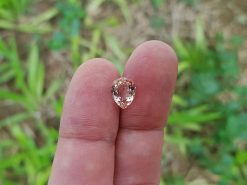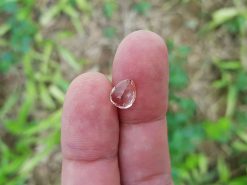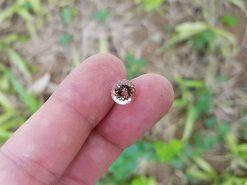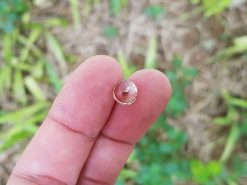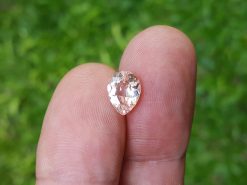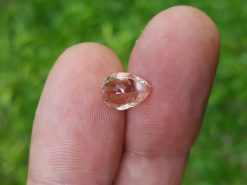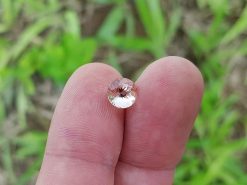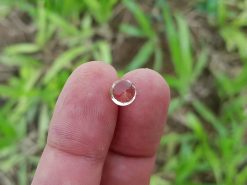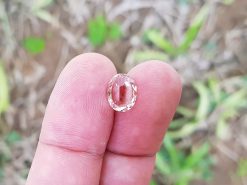Morganite
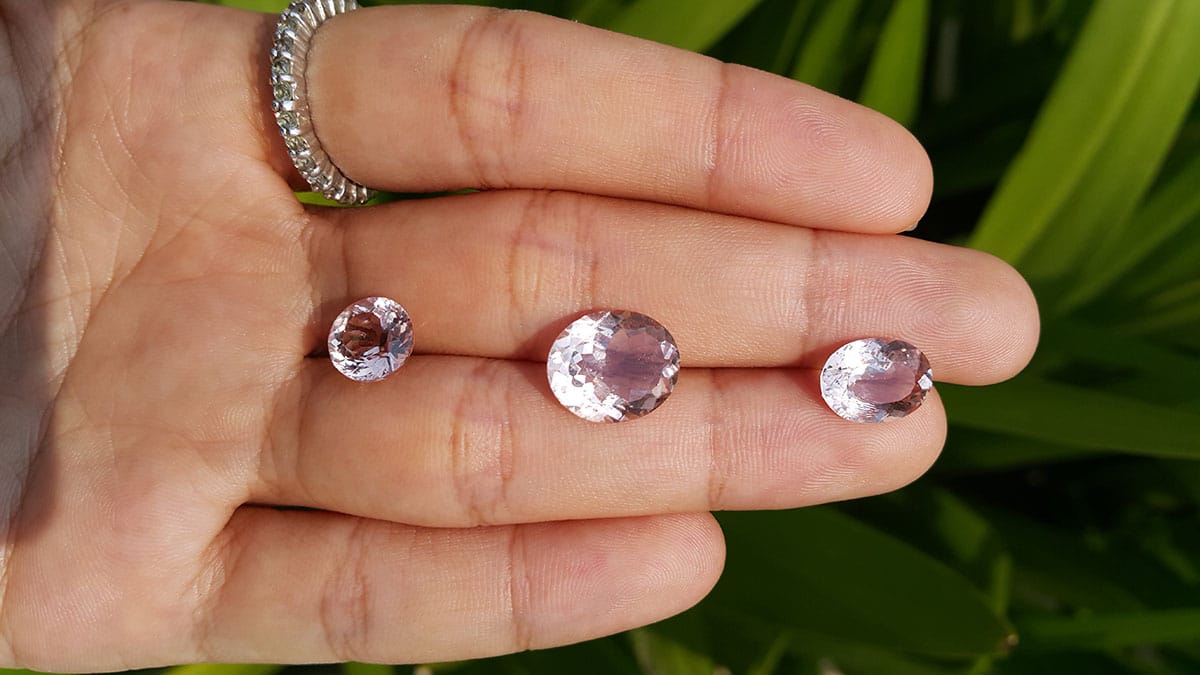
Buy natural morganite in our shop
Morganite gemstone is a rare light pink to orange variety of beryl. Raw morganite crystal stone meaning, cost, price, and value.
Morganite stone is a rare light pink to rose-colored gem-quality variety of beryl. Orange-yellow varieties can also be found, and color banding is common. It can be routinely heat-treated to remove patches of yellow and is occasionally treated by irradiation to improve its color.
The pink color crystal is attributed to Mn2+ ions. In December 1910, the New York Academy of Sciences named the pink variety of beryl after financier J. P. Morgan.
Morganite Origins and Formation
Like other beryl family members, morganite forms in pegmatites and certain metamorphic rocks. The presence of manganese in the crystal structure accounts for its appealing pastel color spectrum, ranging from soft pinks to peachy tones. Morganite is mined in several countries, with notable deposits in Madagascar, Brazil, Mozambique, and Nigeria. Its natural clarity can vary, and many stones may show slight inclusions or color zoning, making each specimen unique.
Morganite Clarity and Color
The clarity of morganite typically leans toward eye-clean, although some inclusions can be present. Since lighter-colored gems often show clarity characteristics more easily, cutters strive to maximize color and brilliance by choosing the best orientation for each rough stone. Morganite’s color can shift slightly under different lighting conditions, sometimes displaying a more peachy or slightly pink hue. Many collectors prize morganite stones for their subtle, feminine palette.
Morganite in Jewelry
Morganite is a popular choice for engagement rings and other fine jewelry. Due to its warm pastel glow, morganite complements both rose gold and white gold settings. Jewelers often favor it for bridal pieces, necklaces, stud earrings, and statement rings. It pairs beautifully with small accent diamonds or other light-toned gems that amplify its delicate color, making morganite jewelry an elegant and timeless choice.
Morganite Hardness and Care
With a hardness rating of 7.5 to 8 on the Mohs scale, morganite is relatively durable and suitable for everyday wear. However, like all gems, it can still be chipped or scratched if not properly cared for. To maintain its brilliance, clean morganite regularly with warm soapy water and a soft brush, making sure to rinse thoroughly. Prolonged exposure to direct sunlight or high heat may fade the color of morganite, so it is best to store your morganite jewelry in a protective pouch or box when not in use.
Pink beryl
Beryl is a mineral composed of beryllium aluminium cyclosilicate with the chemical formula Be3Al2(SiO3)6. Well-known varieties of beryl include
emerald and
aquamarine. Naturally occurring, hexagonal crystals of beryl can be up to several meters in size, but terminated crystals are relatively rare.
Pure beryl is colorless, but it is frequently tinted by impurities; possible colors are green, blue, yellow, red (the rarest), and white. Beryl of various colors is found most commonly in granitic
pegmatites, but also occurs in mica schists in the Ural Mountains, and limestone in Colombia.
Beryl is often associated with tin and tungsten ore bodies. Beryl is found in Europe in Norway, Austria, Germany, Sweden (especially morganite crystal), Ireland and Russia, as well as Brazil, Colombia, Madagascar, Mozambique, Pakistan, Afghanistan, South Africa, the United States, and Zambia.
US beryl locations are in California, Colorado, Connecticut, Georgia, Idaho, Maine, New Hampshire, North Carolina, South Dakota, and Utah.
New England’s pegmatites have produced some of the largest beryls found, including one massive crystal from the Bumpus Quarry in Albany, Maine, with dimensions 5.5 by 1.2 m (18.0 by 3.9 ft) and a mass of around 18 metric tons. It is New Hampshire’s state mineral.
As of 1999, the world’s largest known naturally occurring crystal of any mineral is a crystal of beryl from Malakialina, Madagascar, 18 m (59 ft) long and 3.5 m (11 ft) in diameter, and weighing 380,000 kg (840,000 lb).
Morganite meaning and healing properties
The following section is pseudo scientific and based on cultural beliefs.
Morganite is a magician of the heart and comes with a whole swathe of healing properties. Like all the heart chakra stones, it is a nurturer and always ready to open you up to the wonders that are waiting for you in the wider world.
While it invites love to ebb and flow out, it also turns its gaze and healing vibes inwards, ensuring that you are stacked with self-love, self-respect, and self-care — ready to stand proud no matter what comes your way.
Beryl varieties
- Aquamarine: blue and green-blue
- Aquamarine: blue and green-blue
- Emerald: green because of the presence of chromium
- Heliodor: golden or yellow because of the presence of iron
- Morganite: pink to orange, containing lithium and cesium
- Goshenite: colorless Red beryl (bixbite): red currant supported, rich in manganese.
FAQ
Is a morganite a real diamond?
It is a diamond alternative for an engagement ring. It is the second most popular non-diamond stone, after sapphire. On a dollar-per-carat basis, gemstones are much less expensive than diamonds. A single carat of fine quality costs about $200 to $400, compared to $2,000 to $4,000 for a diamond.
Is a morganite engagement ring tacky?
Not at all! A morganite engagement ring has a refreshing sophisticated note. It sends a message that the bride-to-be who has it is unconventional, but also very classy. People often choose a pink morganite engagement ring, and there is nothing tacky about soft, blush-pink shades.
Is morganite a good investment?
Yes, it is! The word “investment” makes sense in this case because when you purchase an engagement ring, you want it to last for life. The stone wins bonus brownie points over traditional diamonds because of its price factor.
Is morganite a rare gemstone?
Morganite is a rare semi-precious stone. High-quality stones are rare and sought after. Currently, it is readily available due to production in Nigeria and Mozambique. Very high quality with deep color is difficult to acquire, but we do have that available in our store.
Do morganite rings get cloudy?
Morganite is a beautiful stone, but it can easily become cloudy and dull if not cleaned properly. Keep the ring away from lotions and cleaning products, and make sure you scrub it every couple of days to keep it from becoming filthy and dull.
Can morganite be worn everyday?
The stone is safe to wear during most everyday activities. However, like all other gemstones, it can be damaged, so we recommend that you remove your ring before gardening, cleaning, playing sports, or participating in other strenuous activities.
Natural morganite for sale in our gem shop
We make custom-made morganite jewelry as engagement rings, necklaces, stud earrings, bracelets, pendants… Please
contact us for a quote.

